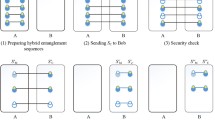Abstract
We demonstrate a fashion of quantum channel combining and splitting, called polar quantum channel coding, to generate a quantum bit (qubit) sequence that achieves the symmetric capacity for any given binary input discrete quantum channels. The present capacity is achievable subject to input of arbitrary qubits with equal probability. The polarizing quantum channels can be well-conditioned for quantum error-correction coding, which transmits partially quantum data through some channels at rate one with the symmetric capacity near one but at rate zero through others.
Similar content being viewed by others
References
Shannon C.E.: A mathematical theory of communication. Bell Syst. Tech. J. 27, 379–423 (1948)
Nielsen M., Chuang I.: Quantum Computation and Quantum Information. Cambridge University Press, Cambridge (2000)
Deng F.G., Long G.L.: Secure direct communication with a quantum one-time pad. Phys. Rev. A 69(5), 052319-1–052319-4 (2004)
Zeng G., Keitel C.H.: Arbitrated quantum-signature scheme. Phys. Rev. A 65(4), 0423121–0423126 (2002)
Zeng G.: Reply to comment on arbitrated quantum-signature scheme. Phys. Rev. A 78(1), 016301–016305 (2008)
Guo Y., Lee M.H., Zeng G.: Quantum codes based on fast pauli block transforms in the finite field. Quantum Inf. Process. 8(4), 361–378 (2009)
Guo Y., Lee M.H.: Fast quantum codes based on Pauli block Jacket matrices. Quantum Inf. Process. 9(5), 663–666 (2010)
Devetak I.: The private classical capacity and quantum capacity of a quantum channel. IEEE Trans. Inf. Theory 51(1), 44–55 (2005)
Jiang L., He G., Xiong J., Zeng G.H.: Quantum anonymous voting for continuous variables. Phys. Rev. A 85(4), 0423091–0423096 (2012)
Calderbank A.R., Rains E.M., Shor P.W. et al.: Quantum error correction and orthogonal geometry. Phys. Rev. Lett. 78(3), 405–408 (1997)
Li Y., Dumer I., Pryadko L.P.: Clustered error correction of codeword-stabilized quantum codes. Phys. Rev. Lett. 104(19), 1905011–1905014 (2010)
MacKay D.J.C., Mitchison G.J., McFadden P.L.: Sparse-graph codes for quantum error correction. IEEE Trans. Inf. Theory 50(10), 2315–2330 (2004)
Aggarwal V., Calderbank A.R.: Boolean functions, projection operators, and quantum error correcting codes. IEEE Trans. Inf. Theory 54(4), 1700–1707 (2008)
Ocko S.A., Chen X., Zeng B. et al.: Quantum codes give counterexamples to the unique preimage conjecture of the N-Representability problem. Phys. Rev. Lett. 106(11), 1105011–1105014 (2011)
Chen, J., Ji, Z., Wei, Z., et al.: Correlations in excited states of local hamiltonians. Phys. Rev. A 85(4), 0403031–0403034 (2012)
Grassl M., Shor P., Smith G. et al.: Generalized concatenated quantum codes. Phys. Rev. A 79(5), 0503061–0503064 (2009)
Bombin, H., Martin-Delgado, M.A.: Topological quantum distillation. Phys. Rev. Lett. 97(18), 1805011–1805014 (2006)
Viyuela O., Rivas A., Martin-Delgado M.A.: Generalized toric codes coupled to thermal baths. New J. Phys. 14, 033044-1–033044-32 (2012)
Wilde M.M., Guha S., Tan S.H. et al.: Explicit Capacity-Achieving Receivers for Optical Communication and Quantum Reading. ISIT, Boston (2012)
Arikan E.: Channel polarization: a method for constructing capacity-achieving codes for symmetric binary-input memoryless channels. IEEE Trans. Inf. Theory 55(7), 3051–3073 (2009)
Bhattacharyya A.: A measure of divergence between two statistical populations defined by their probability distributions. Bull. Calcutta Math. Soc. 35, 99–110 (1943)
Zeng G., Lee M.H.: A generalized reverse block jacket transform. IEEE Trans. Circuits Syst. 55(6), 1589–1600 (2008)
Author information
Authors and Affiliations
Corresponding author
Additional information
This work was supported by the National Natural Science Foundation of China (60902044, 61172184), the New Century Excellent Talents in University, China (NCET-11-0510), and partly by the World Class University R32-2010-000-20014-0 NRF, and Fundamental Research 2010-0020942 NRF, Korea.
Rights and permissions
About this article
Cite this article
Guo, Y., Lee, M.H. & Zeng, G. Polar quantum channel coding with optical multi-qubit entangling gates for capacity-achieving channels. Quantum Inf Process 12, 1659–1676 (2013). https://doi.org/10.1007/s11128-012-0478-4
Received:
Accepted:
Published:
Issue Date:
DOI: https://doi.org/10.1007/s11128-012-0478-4




